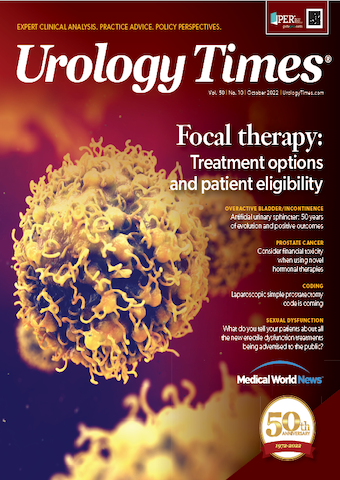Publication
Article
Urology Times Journal
Consider financial toxicity when recommending novel hormonal therapies for prostate cancer
Author(s):
"Ultimately, it will be the treating physician’s responsibility to identify cost-effective alternatives and available resources to help mitigate the financial toxicity incurred from novel cancer therapies," writes Badar M. Mian, MD.
Badar M. Mian, MD

The landscape of advanced prostate cancer treatment has changed dramatically over the past decade. Although novel oral hormonal drugs increase oncologic outcomes (eg, progression-free survival), they also increase financial toxicity for patients. The increase in insurance premium cost is further compounded by increasing out-of-pocket cost (OOPC) for patients because of increasing requirements for deductibles, co-payments, and coinsurance. The rising cost of care may disproportionately affect patients with cancer. Nearly two-thirds of patients with cancer report significant stress related to their medical bills.
To determine the OOPC for patients undergoing treatment for advanced prostate cancer, Joyce et al examined the administrative claims data for commercially insured adults from the OptumLabs Data Warehouse.1 The deidentified data include medical and pharmacy claims, enrollment records, and demographic data including age, race, and region. The authors identified men who received a diagnosis of advanced prostate cancer at various stages (recurrent, hormone-sensitive or castration-resistant, metastatic and nonmetastatic) between 2007 and 2019. Patients with less than 1 year of medical coverage were excluded, and a follow-up of 1 year was required to ensure patients would have met their OOPC.
The primary outcome of interest for this analysis was OOPC in the first year related to treatment with prostate cancer medications, including the sum of deductibles, co-payments, and coinsurance. Total OOPC included the OOPC for all medical and pharmacy claims during the first year of treatment. The type of treatment was divided into these groups: (1) standard androgen deprivation therapy (ADT) alone (including LHRH agonists and antagonists as well as surgical castration); (2) novel hormonal therapy (NHT): apalutamide (Erleada), darolutamide (Nubeqa), abiraterone acetate (Zytiga), and enzalutamide (Xtandi); and (3) nonandrogen systemic (NAS) agents: chemotherapy, sipuleucel-T (Provenge), and radium-223 (Xofigo). Medical or surgical castration was present in 98% and 80% of the NHT and NAS treatment groups, respectively.
For this analysis, there were 13,409 patients who had received ADT (10,926; 81%), NHT (832; 6.2%), and NAS therapy (1651; 12%). The average annual prostate cancer treatment–related OOPCs for the ADT, NHT, and NAS groups were $165, $4236, and $994, respectively. The use of NHT was associated with the highest annual total health care spending ($254,677), followed by NAS therapy ($52,825) and ADT ($778). There appeared to be bimodal distribution of OOPC in all 3 groups, suggesting a minority of patients accounted for the majority of OOPC. For example, in the NHT group, approximately 20% of patients accounted for 80% of the treatment-related OOPC, whereas a small proportion of patients incurred no OOPC.
In the multivariable analysis, after adjusting for baseline patient characteristics, treatment-related OOPC remained significantly higher for NHT, with predicted annual treatment-related OOPCs of $2731, $901, and $150 for NHT, NAS therapy, and ADT, respectively. The total OOPC was similarly higher for NHT and NAS treatments compared with that of DT. Certain patient characteristics were associated with higher treatment-related OOPC, including older age (65-74 years) and Black race. Conversely, lower treatment-related OOPC was noted in patients living in areas with higher household income, higher comorbidity scores, and better insurance coverage, whereas higher comorbidity index scores were associated with greater total OOPC. The data demonstrate that being treated for advanced prostate cancer, after adjusting for patient characteristics, was still 18 times more expensive than ADT ($2731 vs $150) for men with commercial insurance.
The study results provide valuable and actionable insight on the magnitude of OOPC for various treatment options and help identify patients who may be most in need of intervention to ameliorate financial toxicity. This study is among the few studies on the topic of OOPC incurred by patients because of contemporary advanced prostate cancer treatments. Previous study results have demonstrated that for patients with Medicare who do not receive low-income subsidies, the median OOPC during the first 6 months of abiraterone or enzalutamide treatment was $4498. As a result of the increasing financial burden, patients have reported skipping medication doses, foregoing prescription refills, or discontinuing treatments altogether. Other studies have reported Black patients with cancer were more likely to have cost-related nonadherence to medication than White patients.
When discussing health care economics and financial burden, one must recognize the countervailing forces at work. Most hospitals as well as oncology and urology practices, are involved in for-profit pharmaceutical ventures in some fashion. What we consider cost savings may be viewed by others as lost revenue. Strange as it once seemed, our clinics are littered with coupons from companies selling very expensive drugs. Whether these coupons and other pharmaceutical resources effectively reduce the OOPC burden (for those who need some relief) or just serve as window dressing for big pharmaceutical companies is open to debate.
How does a practicing urologist or oncologist help mitigate the financial burden of the ever-increasing OOPC for the patient? Should financial screening be a regular part of the clinical visits? Should a consultation with pharmacy representative or patient advocate be standard practice before initiating expensive therapies such as NHT? Who should be given this responsibility?
A discussion about financial burden of treatment, in addition to the discussion about cancer-related outcomes, prognosis and adverse effects, would pose a challenge to the clinical practice and workflow. But ultimately, it will be the treating physician’s responsibility to identify cost-effective alternatives and available resources to help mitigate the financial toxicity incurred from novel cancer therapies. These may include leveraging available financial support and low-income subsidies, using less expensive but effective alternatives, and/or modifying dosage and schedule based on published literature.
Reference
1. Joyce DD, Sharma V, Jiang DH, et al. Out-of-pocket cost burden associated with contemporary management of advanced prostate cancer among commercially insured patients. J Urol. Published online September 12, 2022. doi:10.1097/JU.0000000000002856

Newsletter
Stay current with the latest urology news and practice-changing insights — sign up now for the essential updates every urologist needs.





























